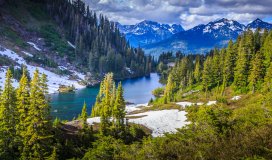Secrets of North East India
Table of Contents

Amongst the Blue Mountains in the Northeastern Indian frontier, there lies an unexploited mélange of social values, customs, beliefs, and culture. These seven states of Northeast India comprising of Arunachal Pradesh, Assam, Manipur, Meghalaya, Mizoram, Nagaland, Sikkim and Tripura are bound together in a holy bond and is popularly summoned as the “The Seven Sisters”. These regions are still unexplored, and many of them are highly concealed with formidable mountains and forests nearly impenetrable. Stores lie deep within its varied trails. The evergreen and ever beautiful seven sisters have many local secrets that are hardly known to people. The obscurity of the place has many hidden treasures and trails that only highly inquisitive travellers like to explore.
Here are some secrets of the North east India, which you can explore and learn:
1. Martial Dance, Karbi Anglong, Assam:

Chong Kedam is a martial dance in Assamese which was performed traditionally by the unmarried male from the Karbi community and is not known or exposed much to outsiders. Dancers dance with swords and shields also locally known as nok and chong respectively. People of the Karbi community are believed to be the descendants to the Karbi Anglong located in the central region of Assam once upon a time. It is the largest district of the state starting from China in its west and all along throughout the courses of river Brahmaputra and Irrawaddy.
The Chong Kedam martial dance narrates the story with complete vigor. In olden days, shields were made from the hide of rhinoceros. But, today they recreate them using other metals due to their endangered status. So, dancer’s men, as well as women, use aluminum and steel variations as they clearly understand the value of Mother Nature. It is a 3 to 5-day festival which connects community members from different villages and states in this region. In the hills of Assam, the performances are held elaborately to honor the Chomangkan festival. It is believed that during these festival men and women appear to be acquiring erotic verbal elements in them. You can visit Assam in January and mid of April and watch Chong Kedam during the Bihu festivals as well. It is also held in early December and during the first week of March. Not many are aware of this authentic performance of the Assamese as it is a best kept secret ritual in the North east.
2. Gambling is Legal in Sikkim:

Very few people know that gambling is legalized in Sikkim. Mayfair Spa Resort, Casino Mahjong, and Royal Casino are three legal gambling avenues in Gangtok. Sikkim after Daman and Goa is another or rather the only state in India which has made gambling a legal affair. Casinos are constructed right on the hotel or resort premises with the proper permission of the government. So next time you are in Sikkim try your luck on any of these casinos.
3. The Last Surviving Headhunters, Nagaland:
They are rare to be seen tribes of the North East. Today they secretly retain and protect their existence in the middle of all advancements happening around them. Naga headhunting has stopped back during the year 1400s. However, there are still some elderly members of the Konyak tribe alive and surviving gracefully in the modern society of the North east. They wear a signature tattoo on their faces to show that they belong to the clan of the once headhunters. Killing and severing off the head of the enemy was a ritual for passage for a young boy in their society in the past. A triumph was always rewarded and the facial tattoo was their prestigious token of appreciation and encouragement for the victorious.
4. Matriarchal Society, Meghalaya:

The only matriarchal society still having its footprints in India is in Meghalaya. No one much knows about this. It is the famous Khasi tribe and one of the few communities in the entire world to follow a matrilineal system. The head of the household is the women of the family in a matriarchal society. It is also the women who work hard for earning a living for their family. Men of these families take up a back seat. So in a matriarchal society in the Khasi tribe in Meghalaya in North East, when a girl is born it is something which is celebrated with much more grandeur than a boy. A boy in a family is accepted as a humble gift of God.
See More: 10 Reasons Why Meghalaya Should be Your Next Holiday Destination
5. Mother’s Market, Imphal, Manipur:

The Mother’s Market in Imphal, Manipur has women as vendors who are making a successful business for nearly over 100 years now. “Ima” signifies mother and “keithel” signifies market. Over 3500 women sell foods, clothes, utensils and a large number of handicrafts in the community here in Manipur. This is a women-centric market very rarely seen in the modern world.
6. Battle of Tennis Court:

This is a quirky historical fact secretly preserved and explored right from the lands of the Northeast. During the Battle of Kohima in the year 1944, which occurred during the Second World War, in the garden area of the Deputy Commissioner”s bungalow, was a tennis court. So the Battle of Kohima for some reason is also known as the Battle of Tennis Court. The addition of the words “tennis court” to the name of the Battle is rarely witnessed anywhere else in the world.
7. Village Shared by Two Countries:

Longwa, in Nagaland, is situated in a very unique territory in the Northeast of India. The village is located in the international borders and this land is shared by India and Myanmar both. The international border passes right through the home of the chief of the village of Longwa. So, basically, half of the residences in Longwa village lie in India and the other half in Myanmar. So, Longwa belongs to both countries. The residents of this village have dual citizenship. Hence, they do not require any special visa to move along in and around their village space.
8. Cleanest Village in Asia:
Mawlynmong, located around 100 km from Shillong is the cleanest village in Asia. Not many of us know about this village. The best part but rarely mentioned fact about this village is that it has 95 families staying in it and have a literacy rate of 100%. This is the most shining village in the North East of India, which is a competition to any other villages in India.
9. Unakoti, Tripura:

Unakoti is a place in Tripura where hundreds of huge rock-cut sculptures of Lord Shiva lie unexplored. It is believed that the sculptures are lying there since 8-9th centuries. Legends say that Lord Shiva stopped at this place while going to Kashi. Since his companions did not wake up before sunrise, he crushed them into these stones and continued towards his destination. Its major attractions include the 33ft high bust and 11ft high headgear of Lord Shiva. 180 km from Agartala and 8km from Kailasahwar town, the nearest airport is Agartala, from where you can take a cab or bus to Unakoti. Kumarghat is the nearest railway station, from where you can reach Unakoti by road. Helicopter service is also available from Agartala and Kailasahwar.
Northeastern states in India are a unique mix of culture, majestic creations from Mother Nature and inspiring and quirky values. All these states of the Northeast are not only closely knit with one another but also there is an inter-cultural connection which people have developed and maintain here. Every place you visit in the North east will leave you mesmerized. Some of the secrets are still wrapped while some are left open for travellers to explore. You can definitely start by exploring any of the secrets discussed above.
See More: The 10 Least Visited Indian States & Why You Should Go There



